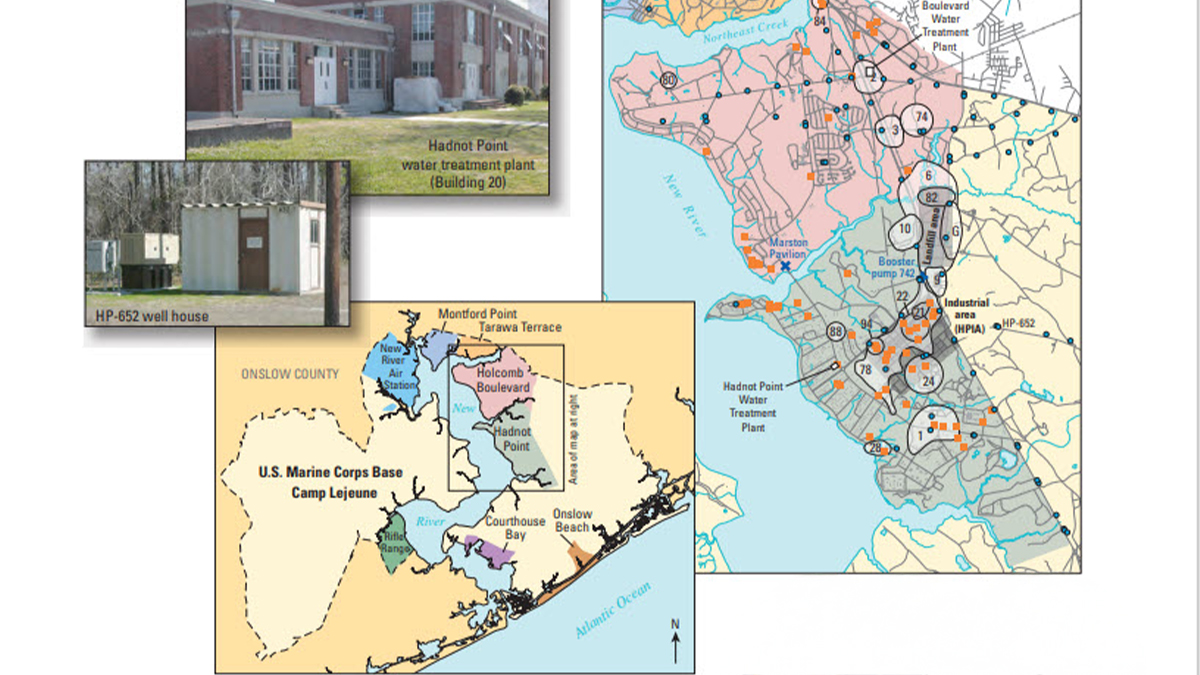What to know
During 2007-2009, ATSDR published historical reconstruction results for Tarawa Terrace and vicinity. Results for Hadnot Point, Holcomb Boulevard, and vicinity – based on information gathering, data interpretations, and water modeling analyses – are presented as another series of ATSDR reports supporting current health studies.

Chapter A: Summary and Findings
Report (text, figures, and tables) – 3/15/2013
Chapter A presents summaries of analyses and results of reconstructed VOC-contaminant concentrations in water supply wells and drinking water in the Hadnot Point and Holcomb Boulevard water treatment plant service areas. This report summarizes previous analyses and investigations—Chapters B, C, and D—and results of water modeling investigations.
Chapter A Fact Sheet – 3/15/2013
Supplements
- Supplement 1: Descriptions and Characterizations of Data Pertinent to Water-Supply Well Capacities, Histories, and Operations
- Supplement 2: Development and Application of a Methodology to Characterize Present-Day and Historical Water-Supply Well Operations
- Supplement 3: Descriptions and Characterizations of Water-Level Data and Groundwater Flow for the Brewster Boulevard and Castle Hayne Aquifer Systems and the Tarawa Terrace Aquifer
- Supplement 4: Simulation of Three-Dimensional Groundwater Flow
- Supplement 5: Theory, Development, and Application of Linear Control Model Methodology to Reconstruct Historical Contaminant Concentrations at Selected Water-Supply Wells
- Supplement 6: Source Characterization and Simulation of Fate and Transport of Selected Volatile Organic Compounds in the Vicinities of the Hadnot Point Industrial Area and Landfill
- Supplement 7: Source Characterization and Simulation of the Migration of Light Nonaqueous Phase Liquids (LNAPLs) in the Vicinity of the Hadnot Point Industrial Area
- Supplement 8: Field Tests, Data Analyses, and Simulation of the Distribution of Drinking Water with Emphasis on Intermittent Transfers of Drinking Water Between the Hadnot Point and Holcomb Boulevard Water-Distribution Systems
Chapter B: Geohydrologic Framework of the Brewster Boulevard and Castle Hayne Aquifer Systems and the Tarawa Terrace Aquifer
Report (text, figures, and tables) – 1/19/2012
Chapter B explains the geometry and extent of the underground layers of sediment and groundwater beneath Camp Lejeune, including aquifers and confining units. This information is a foundation for understanding groundwater flow and conducting water modeling. The information will help scientists understand how contaminants in groundwater migrated to wells and were delivered to water distribution systems at Camp Lejeune.
Master Plate – 1/19/2012
This is a map of the location of Wells and Boreholes, Installation Restoration Program Site Areas, Above-Ground and Underground Storage Tank Sites, and Water-Distribution Systems (2004), Hadnot Point, Holcomb Boulevard, and Tarawa Terrace and Vicinity, U.S. Marine Corps Base Camp Lejeune, North Carolina.
Chapter B Fact Sheet – 1/19/2012
A summary of the Chapter B report
Chapter C: Occurrence of Selected Contaminants in Groundwater at Installation Restoration Program Sites
Report (text, figures, and tables) – 10/22/2010
This report describes the occurrence of selected contaminants in groundwater at installation restoration program sites within the service areas of the Hadnot Point and Holcomb Boulevard water treatment plant areas and vicinities at U.S. Marine Corps Base Camp Lejeune, North Carolina. Among contaminants of interest to the current ATSDR health study described in this report are tetrachloroethylene (PCE), trichloroethylene (TCE), benzene, and vinyl chloride. The report consists of 282 pages, 34 illustrations, 80 tables, and 1 plate (map).
Master Plate – 10/22/2010
This is a map of the location of Wells and Boreholes, Installation Restoration Program Site Areas, Above-Ground and Underground Storage Tank Sites, and Water-Distribution Systems (2004), Hadnot Point, Holcomb Boulevard, and Tarawa Terrace and Vicinity, U.S. Marine Corps Base Camp Lejeune, North Carolina.
Chapter D: Occurrence of Selected Contaminants in Groundwater at Above-Ground and Underground Storage Tank Sites
Report (text, figures, and tables) – 12/04/2012
This report summarizes results of investigations at 64 designated Resource Conservation and Recovery Act (RCRA) study areas and emphasizes the occurrence and distribution of refined petroleum products such as benzene, toluene, ethylbenzene, and xylene (BTEX) within areas served by the Hadnot Point and Holcomb Boulevard water treatment plants.
Chapter D Fact Sheet – 12/04/2012
- View as webpage
- Chapter D Fact Sheet - A summary of the Chapter D report

